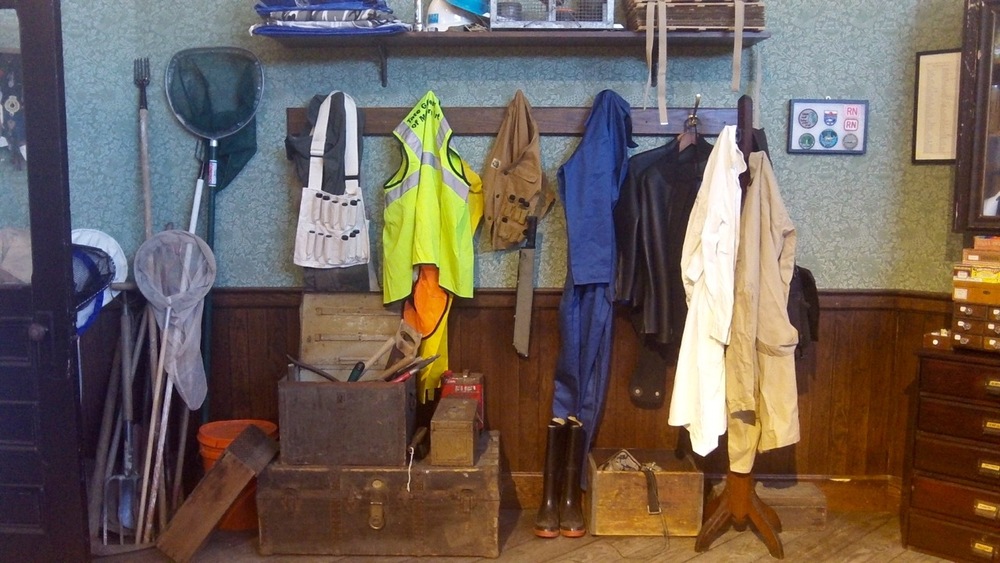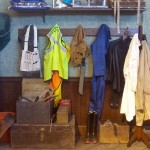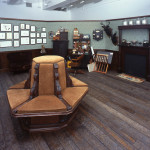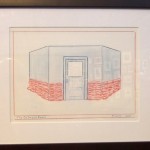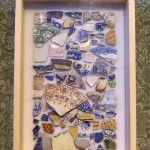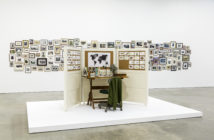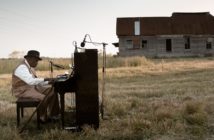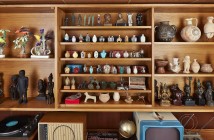Recently, I had the chance to sit down with Mark Dion on The Octagon Room’s central Victorian velvet—and appropriately octagonal—settee. Here’s some of our conversation.
Mark Dion I'm always deeply impressed when I come to MASS MoCA and see how many people are here. When you go to MoMA you're overwhelmed by how many people are there. But it's the most significant collection of modern art in the world, so it's no surprise, and it's in the middle of a city of 8 1/2 million people. But when you come up here it is remote from any major city, and it is packed every time! I've never been here when I wasn't surprised by the attendance.
Samuel Rowlett But still there's so much room you can almost have the artworks all to yourself.
MD True, and the audience is very diverse, I love how it is here. I like the way that MASS MoCA, without pandering, really does a great job at meeting a broader audience half way. I think that is so important, they have really become masters at how to do it without doing something that's going to make the audience cringe.
SR It is almost a democratized philosophy.
MD I think that there's a kind of artist, who has a very good dialogue here. Someone like Michael Oatman is a good example of an artist who really makes a commitment to a place and the place makes a commitment to him to realize an ambitious project. I feel similar in that way, from doing projects here over the years I’ve gotten to understand how this place works, it is unlike any other.
SR Do you see this way of working as kind of "embedding" yourself as an artist into a community?
MD It is interesting when you come from a family where art is not part of that everyday experience, you understand what it means to find your way to art, through encounters with it, as opposed to it necessarily being part of your culture.
SR To forge, or rather to hack away at it through all the other stuff? I can't help but wonder what you got up to as a kid? Did you have hobbies? Has this way of thinking and making art been something that was always there for you?
MD There's a lot of New England in me, and a lot of me in New England. I am, in some way, really a product of growing up in New England and in Massachusetts. Specifically growing up in New Bedford, we had this incredible proximity to the gritty postindustrial landscape; what's left of the fishing industry, and remnants of the textile industry. Playing in abandoned factories and spending time on the docks in the industrial seaport were things we did as kids. On the other hand, a bicycle ride away, you were on the pristine South Coast beaches, with sand dunes and salt marshes.
Every summer we would go to the beach, at least three times a week, and as the car would park, most people would get out and head right towards the beautiful sandy beach, but if you went to the left you were in Spartina grass, and salt marshes with blue crabs, fiddler crabs, eels, and creatures like that. So I was always spending my time there, exploring.
When I was a kid, I felt like I was surrounded by history, by abandoned farms, digging in old bottle dumps; we spent a lot of time in the landfill. In a way a place like New England can contain several environments in miniature. Essentially we lived in the suburbs, but on either side, within equal distance we could be in still-active farmlands, or postindustrial seaport, or beach, or woods, or a fragment of an old orchard. So my idea of nature was never pure, or wilderness based—like a place with grizzly bears—but a place with seagulls and rats. Which isn't any less natural, it's just that that model of pristine wilderness wasn't my model. My nature was always a nature that was resilient, and a nature that existed side-by-side with agriculture, industry and former industry, and when industry stopped nature was what took over.
SR I think about a kid going out into a world like that, the skill set you would have to have two explore that kind of environment: part archaeologist, part biologist, part ecologist…
MD I'm sure the template for a lot of my work and interests was set back then by those experiences. It was an active relationship with knowledge. There were also great libraries where I lived, and the first museum I ever went to was the New Bedford Whaling Museum. Which is a museum of natural history, social history, vernacular art, fine art; all of it cobbled together under one roof. You had ship models side-by-side with whale skeletons, side-by-side with Hudson River school painters, side-by-side with scrimshaw and art glass. So the idea of all these types of knowledge under one roof was not an alien one for me, it was always kind of the way things were.
SR Sort of encyclopedic in a way? I had a similar experience in St. Johnsbury, Vermont. After school I would spend time at the St. Johnsbury Atheneum or the Fairbanks Museum and Planetarium and it seemed to me that there was an "art of collecting", and a way of collecting art that you don't see today. I wonder as a kid were you a collector of things?
MD Yes I had collections, but I didn't really have a support network for it. I think one of the reasons why my work always has butterfly nets in it is because growing up as a kid I didn't have a butterfly net. I didn't really know who to ask for something like that, I mean my parents were supportive, but not in that way. But I couldn't really say, "I need a butterfly net," because they wouldn't know how to get something like that. I wouldn't know where to get something like that. So I think that's part of my obsession with apparatus, it comes from this kind of impoverishment.
You know kids have these books, if you're interested in science, "25 experiments you can do at home," or something like that. Every kid has a book like that. I remember trying to do some of those experiments, and they would say, "First you need an eyedropper and a cork." And I'd be like, oh my god where can I get a cork, I'd never even seen a cork, my parents didn't drink. Even an eyedropper, these are not exotic things, just in my world and very limited experience it just seemed impossible. I always felt that these things were beyond my grasp. So maybe that's why I'm so keen on apparatus now.
SR You seem to have an obsession with the tools with which to collect specimens or what have you.
MD I think that that comes through, in the way that there are a lot of tools in this installation, it's also about the concept that artwork is "work." It's really a very active kind of process. So, for me that's really something that I want to translate through.
SR When you process through an idea where does it start for you? Do you start with a drawing or…
MD It always starts with the site itself. Much of my work is site related. I'm always thinking, "Where is this? Who is this for?" All of these issues are primary, and the site tells me what to do.
SR So, if we consider objects as encapsulated things, do you see the site then as a container, or do you see the objects first? How does that work for you?
MD I think the site for me is a really expanded thing. It can be the architecture of a particular place, but it is also the social history of the place. What's special about this place? What is it known for? It's also about the people. All of these things come into play when I arrive somewhere. What I’m looking for is a little like troubleshooting. I’m brought in as a kind of foreign expert to figure out how to deal with a place. It's really problem solving, there's something here that I can see that maybe the people on the ground don't see, and what is that thing? Of course I don't come to the site empty-handed, or empty minded, I also bring my own bag of tricks. For example, I’m interested in the history of the representation of nature, the history of science and of the location, particular figures who might be telling of the place. What makes this a special place and in the categories of knowledge that I'm interested in? I'm searching for, hunting for, that difference.
SR So when you come to a site where do you begin?
MD It always starts with research, which leads to notebook drawings. I keep a very active sketchbook/notebook, which is really important. From that I generate these process drawings, which, as the next stage, help me to visualize what the work is going to look like. Those drawings over there are of The Octagon Room, they are what I show to the people who actually built this room. Because I am no longer the person who builds the structures anymore, it's just not very efficient for me to do so. I'm not really a studio person. So I need a way to translate, but not over determine happens. I respect the skills of the people I hire to help construct the work.
SR So is your sketchbook your studio then?
MD Yeah, in a way, yeah. For me it's really the most interesting part. But work like this (The Octagon Room) is very different for me; this work is endlessly detailed. I've never done a work that is so autobiographical. It's based on a kind of experience of self, and of self-examination, it is not really typical for me.
SR Is it a self-portrait in a way?
MD In a way it is, yes. I think it's a self-portrait of my artist-character. It might not be me per se, but it's certainly the person I project professionally in the art world. That person probably knows more about science than I do. He's a very different kind of character in some ways.
SR Do you ever see your role as an artist blurred between artist, scientist and curator?
MD Yes, I'm not very obsessed with categories, or with definitions. I don't really care if people even see this as "art" or not. I care if they see it as interesting. I care if it's an interesting endeavor for them, something that challenges them, and something that engages them. I think about the audience a lot. I was recently giving a lecture in Holland, at one of the art schools there, and afterwards some of the faculty came up and they said, "It's so great you kept talking about audience, you kept talking about the viewer." I said, "Well why wouldn't I?" They said "Nobody talks about the viewer here, you don't make art for an audience, you make art for yourself." I was like, whoa, I've never had that concept in place; that the work is all about me in a sense. That notion, which seems to me like a very sophomoric notion of making art, continues to dominate in some places.
SR Thinking about how the viewer articulates with the space, how do you see their role? Do you see the viewer’s presence somehow completing the piece?
MD Absolutely, I think that art is a very communicative form. It's just that what it's communicating is not so cut and dry. It's not so clear, it's not so precise, or so didactic in a way. The viewer plays a very important part in the construction of meaning, but what that meaning is, and the meaning they construct can be quite a bit untethered from what I intend.
SR It's funny you bring up meaning, I was thinking about semiotics and Ferdinand de Saussure, and the meaning of meaning and how we arrive to it. Thinking about your work in terms of its relation to the creation of context. In your opinion, can a singular object ever exist without context?
MD For me, no. It's funny, I have friends that have this art appreciation technique, that is a little bit of a combination between art appreciation and meditation. They try to deal with an object all on its own. For me that makes no sense. I'm trained in a kind of Marxist tradition, where context and history is everything, so I cannot—nor could I even understand why one would want to—remove context from the work. It's always about who's speaking, it is always the first question for me. I think that that's an interesting thing.
You know for me this piece comes from reflecting on a very strange time, which is the "Bush years."1 I was a young artist during the Reagan years, and from the art community there was a great deal of pushback against a very repressive culture. In a way that was very fruitful, and I think that that's what I anticipated, or imagined could’ve happened during the Bush years. But it didn't. I'm always wondering why it didn't? I'm also not pointing fingers at anyone, because I'm also asking why I didn't. So in a way The Octagon Room represents a kind of retreat. Those years were so overwhelmingly grim. People did turn inward in a way. It was very much like what you hear about French intellectuals during the World War II occupation. The way many resisted was just to not participate. They seemed to withdraw into themselves. Unless you were a physical person, on the front and joined the resistance, maybe the only solution you had was to withdraw. So I think there's something akin to that here. This piece is about me trying to figure that out.
SR Is it questioning your own judgment in a way?
MD Yeah absolutely, I see it as a critical piece in some way. This is how I fiddled while Rome burned. So, it's not entirely uncritical, it's a little bit like designing your own prison cell. You know it's like, were I to go to jail I'd want to bring these books, and I’d want to do this or that. So there's kind of a fantasy about it as well.
SR Do you think the sort of "apathy" from the art world came from the specter of terrorism, like "you're either with us, or you're against us?"
MD I think it was less apathy, and more like tremendous ambivalence. There’s also the fact that you could retreat into a microcosm of consensus. What it meant to be an artist during the "Bush years" in New York was probably very different from what it meant to be an artist in, say, Cleveland. It's kind of like back in the prohibition days, nobody actually stopped drinking in New York. It was this isolated place where things didn't really change. However in other parts of the country it was impossible to continue with business as usual.
SR Do you ever feel that in your work you have to engage in that political dialogue?
MD I think my work does. There are a lot of artists whose work engages in a political dialogue who wouldn't see me doing that in my work at all. But, I have always seen my work in a political context. At the same time it is not necessarily didactic, although my early work was very didactic, very overt. I thought the ecological crisis was really an information crisis. It was really about people not knowing. I think that's an impossible argument to make now, people know. It's not a crisis of information it's a crisis of political will. Which is totally different.
SR So, going back to the objects, and the space, or place, there is a theory about how native objects, which when stripped from their original context become meaningless. I was thinking about that, and that's sort of the idea of an art museum, to take an object and present it without much context.
MD I think the museum's job is to somehow restore some kind of representation of that context too. And that's the key difference between a museum and an art museum. An art museum is a place where you can have things without context. You can have a painting from the 16th century and it might not say anything more than the date and the artist name and the medium. So that would seem really insane to someone working in an ethnographic museum or in a natural history museum.
SR I wonder why that is?
MD Yeah, why is it that way with art? Because I think there's a tradition in art history, which comes from aesthetics and doesn't necessarily emphasize historical context. The origins of art history, as a field, are not so old, and they tend not to talk so much about context.
SR Do you think of the objects that you're using as being plucked out of the stream of time?
MD I think that they drag some of that time with them. There’s a difference between that old, used pitchfork and the one I bought at Home Depot. So that's why I struggle very hard to find very particular things. My main method as an artist is shopping. That's what I do, and that's probably the most important thing I do. So, I'm very particular about what I buy, and what it looks like, and how it articulates how I want those objects to speak.
(At this point exhibition curator, Denise Markonish walked up and overheard what were talking about.)
Denise Markonish He has an eagle eye, I've been to so many antique shops with Mark, and I’ll make a full lap and look at everything and I think there's nothing here. When I come back, his arms are full of antiques! He can look at a pile and see just the right thing.
MD It's just a skill that you learn.
SR Ha! So if we asked the question of objects and context the opposite way, can context be created without objects?
MD Context without objects?
SR Or do they bring, or drag as you were saying, with them a predetermined context?
MD Yeah, I think The Octagon Room is an example of that, this is a totally convincing and strange space, but it's made of nothing. I mean it's just all theater. All of these objects are creating this context, which is very, very specific, but very theatrical. I think that that is what this endeavor is in a way, what installation is to me. When I first heard about installation art, when I was in art school, there was this generation of artists from the '70s like Mary Lucier and Rita Myers, the first real video installation artists. Coming out of performance there was this notion that when you're doing installation you're making an environment, one that has a transportive aspect. It's not entirely unlike theater in a sense.
SR I feel with your work, that I am studying these objects with all this peripheral information.
MD It is important that the objects have specificity to them, but it's not about archetypes, it's really about the things being themselves, not representing something else. As many of these things as possible are things that have actually been used.
SR So do you see this stuff as relics or even evidence of a period of your life?
MD The ideas of the artifacts themselves are really interesting to me. I’m interested in questioning the notion that when we see a fragment of something it has a kind of problematic place because it has been removed from "use value." In a sense it becomes a sign for an activity.
SR So if this were your prison, as you were saying earlier, how would you spend your days?
MD Well, it implies that I could just continue on. There are so many tools here. I could continue my drawing practice. I could leisurely read many of the books that have been important to me and some that I haven't got around to reading yet. A lot of the things are thoroughly cataloged here, but there's always room for refinement. I could send packages out to the rest of the world, which I often do. I'm very invested in postal art. The idea of prison is that you're no longer allowed to do the things you want to do, here I could continue to do those things.
SR I guess it's less of a prison and more of a . . .
MD . . . Sanctuary, yes. I've thought of it a little like Superman's Fortress of Solitude. When this was made we were very much at war, but no one acknowledged that we were actually at war. It wasn't even part of the conversation. If you walked through Chelsea at the time, over consecutive months you would never know this was a country at war. There was nothing about it. There was virtually no art being made that actually engaged was as a fact. I always thought that was incredibly weird. This wouldn't have been true during the Vietnam War. Why is it all of a sudden? Which is exactly part of the strategy of this war, to create a kind of war situation where most people felt like it wasn’t costing them anything. For university educated liberals in New York it didn't cost them anything, it wasn't their blood being shed it wasn't the blood of the people around them.
SR Do think that may have been market driven?
MD I think it was politically engineered, a way of ideological engineering, which is something that has gone on long before the Gulf War. How do you avoid the situation with the Vietnam War where you have rebellion on the home front? Well, you don't ask anything from the middle class, because you don't fuck with the middle class. Because, if you do, you have a revolution on your hands. So it was an incredibly clever thing they did.
SR And we're still not feeling the war(s).
MD Yeah, so that became the whole idea of presenting, at least from the outside, this encounter with the bunker. From the inside of this piece it is hard to remember that the outside is all sandbags and concrete walls. That is something that is very interesting to me, the notion that it's so easy to forget while you're in here that on the outside it is quite a brutalist form.
SR Maybe it's a metaphor for the mind?
MD Yes, it is like a brain. It is a mind model, with distinct sections. Here is the work and apparatus section, here's the other world (or literally the rest of the world), here is archaeology, this is inspiration, this is melancholy and regret, the brick fireplace the ashes from my archives, here is intellectual labor, sketches and materials
SR I guess have to ask, have you ever been accused of being a hoarder?
MD People imagine I'm a hoarder all the time, but it's not the case.
SR It’s all material, right?
MD Yeah, I don’t have an unhealthy relationship to collecting. It is something very specific and controlled.
__
Eagle eye indeed.
Mark Dion’s The Octagon Room is on view at MASS MoCA through January 20, 2014.
- Mark Dion, The Octagon Room, 2008 (2013)
- Mark Dion, The Octagon Room, 2008 (2013)
- Mark Dion, The Octagon Room, 2008 (2013)
- Mark Dion, The Octagon Room, 2008 (2013)
[1] When president George W. Bush was in office 2000-08

